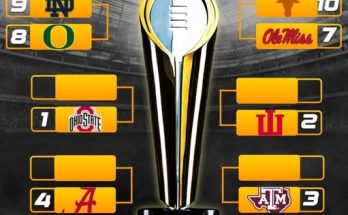BREAKING: In a stunning turn of events that has sent shockwaves through the collegiate softball world, the No. 1 top-ranked high school player in the nation has officially decommitted from Texas Tech and announced her commitment to the powerhouse Oklahoma Sooners. The decision, confirmed by both the athlete and Sooners insiders, marks one of the most high-profile recruiting flips in recent memory and instantly adds another elite weapon to an already loaded Oklahoma roster. For Texas Tech, the news is a gut-punch—a major recruiting victory turned disappointment, leaving fans and coaches scrambling for answers and reassessing the future trajectory of their program.
The player, widely regarded as a generational talent with elite hitting mechanics, defensive versatility, and unmatched softball IQ, had been committed to Texas Tech for nearly a year. During that time, she had been seen as the centerpiece of the Red Raiders’ incoming class and a future cornerstone for the team’s revival efforts. Her social media presence, interviews, and even public appearances at Texas Tech games suggested a strong and enthusiastic commitment. All of that changed within the span of a few hours as news broke across platforms that she had flipped her allegiance to Oklahoma—a juggernaut program fresh off yet another Women’s College World Series triumph and an unrelenting run of dominance under head coach Patty Gasso.
The announcement came via a carefully worded social media post where the athlete thanked Texas Tech for believing in her and said the decision was made with a heavy heart. But what followed was a statement that lit up the softball community: she was officially committing to the University of Oklahoma. The reaction was immediate. Oklahoma fans erupted in celebration, Texas Tech supporters expressed a range of emotions—from heartbreak to frustration—and analysts began dissecting what had happened behind the scenes to lead to such a seismic shift.
According to sources close to the situation, the athlete had long admired Oklahoma’s program, its culture of winning, and the development pipeline it offers elite players. Oklahoma’s track record speaks for itself. With multiple national championships in the past decade, record-setting winning streaks, and an atmosphere that draws comparisons to pro-level play, the Sooners offer an opportunity few athletes can resist. Moreover, playing under Patty Gasso, a coach considered by many as the greatest in the sport, presents not just a path to collegiate stardom but a fast track to national team selection and even professional opportunities down the road.
While some insiders claim that this move had been brewing quietly for a few weeks, others were caught completely off guard. Texas Tech had built its recruiting class around this player, emphasizing her impact on and off the field. She was expected to bring immediate production, leadership, and a competitive edge that could have helped the Red Raiders climb out of the Big 12 cellar. Her decommitment now leaves a significant void—both symbolically and strategically—for the program.
Texas Tech’s coaching staff, which had invested heavily in this recruitment, released a brief statement acknowledging the change and wishing the athlete well. The tone was respectful, but there’s no denying the sting. In collegiate recruiting, especially in the high-stakes arena of Division I softball, these kinds of flips are rare but not unheard of. What makes this case so notable is the combination of timing, player stature, and the programs involved. This wasn’t just a decommitment—it was a migration from a rebuilding team to a reigning dynasty.
The ripple effects are likely to be felt far and wide. For Oklahoma, this addition could fortify an already imposing lineup. The Sooners have consistently ranked at or near the top in both offense and defense, and adding a player of this caliber only widens the gap between them and their closest competitors. Her skill set—highlighted by blazing speed, clutch hitting, and acrobatic fielding—perfectly complements Oklahoma’s high-octane style of play. With her arrival, the Sooners’ batting order grows deeper, their infield more agile, and their postseason outlook even brighter.
For Texas Tech, the challenge now becomes twofold. First, the coaching staff must quickly pivot in recruiting, looking to either find a replacement of similar caliber—a tall order given the late timing—or develop existing prospects into future stars. Second, they must work to maintain morale and momentum in a program that has struggled to gain a foothold in a conference dominated by the likes of Oklahoma, Texas, and Oklahoma State. Losing a player of this magnitude could deflate both locker room energy and fan support unless carefully managed.
This move also reignites the broader conversation about the power dynamics in women’s college softball. Oklahoma’s success has created a gravitational pull that draws in top-tier talent from across the country. Critics argue that such dominance risks creating a competitive imbalance, where only a handful of programs are seen as viable destinations for elite players. Supporters counter that Oklahoma’s success is well-earned through superior coaching, facilities, and player development—and that the burden lies on other programs to rise to the challenge.



